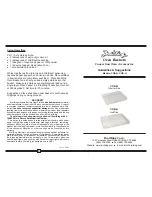
SM810
DOOR/WINDOW DETECTOR
The Door/Window Detector is a Z-Wave Plus
TM
enabled device and is fully compatible with any Z-Wave
TM
enabled network. The device can be set up in a Z-wave network to communicate directly with other end
devices such as lighting controllers, or to report directly to a Z-wave controller (usually a gateway).
Z-Wave
TM
enabled devices displaying the Z-Wave
TM
logo can also be used with it regardless of the
manufacturer, and ours can also be used in other manufacturer’s Z-Wave
TM
enabled networks.
Inclusion of this Door/Window Detector on other manufacturer’s Wireless Controller menu allows remote
turn-on of connected modules and their connected lighting when the Detector is triggered.
Product Overview
LED
TAMPER
SWITCH
BATTERY
BATTERY
MYLAR
FIXED
SCREW
Adding to Z-Wave Network
Auto Inclusion
The detector supports Auto Inclusion feature where it will automatically enter Inclusion mode when first
powered up after a factory reset.
1.
In the front casing, there is a tamper switch which is used to carry out inclusion, exclusion or reset.
2.
Put a Z-Wave Controller into inclusion mode.
3.
Insert 2 CR2032 batteries to the battery compartment with the correct polarity. The LED on the
device will turns on.
4.
The Inclusion process should be completed when the LED turns off.
Note: If Auto Inclusion fails, refer to the Troubleshooting section regarding Manual Inclusion.
Testing
1.
Remove the battery cover with the tamper switch not being pressed on the detector (test mode),
detach or close the magnet from the Detector, the LED on the detector will illuminate.
2.
After proper installation and test, put the battery cover back to the detector and the detector enters
the normal mode.
Note: After removing batteries, wait for 5 seconds to refit batteries.
Mounting the Detector
Choosing the location
The Door/Window Detector is suitable for mounting in dry interior locations only.
Decide which doors/windows are to be protected by Door/Window Detectors, (usually the front and back
doors as a minimum will have Door/Window Detectors fitted). Additional detectors may also be fitted
where required to other vulnerable doors or windows, (e.g. garage, patio/conservatory doors etc).
Note
: Take care when fixing the Detector to a metal frame, or mounting within 1m of metalwork (i.e.
radiators, water pipes, etc) as this could affect the radio range of the device. If required, it may be
necessary to space the magnet and detector away from the metal surface using a plastic or wooden
spacer to achieve the necessary radio range.
Installation
1.
Use the adhesive tape to fit detector on the door or window.
2.
Fit the magnet to the moving part of the door/window opposite the detector using the adhesive tape.
3.
Ensure that the parallel gap between the magnet and detector is less than 20mm and that the
matching line on the magnet is pointing towards and aligned with the line on the detector. An alarm
condition will be occurred if the gap is greater than 35mm.
Operation
1.
If first use of SM810 with no node ID, LED will turns ON for 30 sec. when first power on the device
to lead the user for auto inclusion. After Inclusion is completed, the device will stay awake for 25
sec. for set up by user from the controller. After 25 sec., the unit will enter sleeping mode, if set up
is still needed, the user can press tamper switch for SM810 to be awake for another setting.
2.
Due to limited power from CR2450, the unit may not continuously operate for a long time due to
power consumption. Therefore, set up time for SM810 should be minimized, and repeatedly
press of Tamper should be avoided as well, in order to prevent unusual incident by a quick battery
voltage drop down.
3.
User can enter test mode by releasing the Tamper switch; in the meantime if magnetic sensor is
triggered then the LED will be illuminated. User can confirm whether the Tamper switch has been
pressed properly by implementing this function. When Tamper switch is to be pressed and enter
normal mode, LED will not be illuminated even if the magnetic sensor is triggered, unless low
battery is detected.
4.
When the tamper switch is pressed, the unit enters normal mode and the red indicator LED on the
Detector will not illuminate to conserve battery life when the detector is triggered, (unless the battery
power is low).
Battery Cover
45°
Battery Cover
CR2450
Battery
Detector
Magnet





















